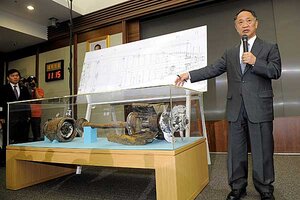North Korea rebuffs South Korea's evidence on Cheonan attack
South Korean defense officials presented evidence Thursday that a North Korean submarine torpedoed the Cheonan, a South Korean Navy ship, in March, killing 46 sailors.

Yoon Duk-yong, right, co-head of the team investigating the sinking of the South Korean warship Cheonan, stands next to torpedo parts salvaged from the Yellow Sea during a press conference at the Defense Ministry in Seoul, Thursday.
Jung Yeon-je/AP
Seoul, South Korea
South Korea’s Defense Ministry Thursday formally charged North Korea with the attack on a South Korean Navy ship that killed 46 sailors – in the face of angry denials from North Korea, including a threat of “all-out war” if the South responded militarily.
North Korea’s National Defense Commission, chaired by the country’s leader Kim Jong-il, issued its statement in the midst of a briefing by South Korean defense officials on the torpedo they say split and sank the Cheonan.
Pyongyang offered to send its own investigators to South Korea to examine the evidence as weighed by a team of investigators from South Korea, United States, Britain, Australia, and Sweden. The offer was viewed as rhetorical, though, since North and South Korea have stopped virtually all talks.
International attention
While the leaders of the defense team explained in detail how the torpedo sank the corvette on March 26, South Korea’s President Lee Myung-bak promised “resolute countermeasures” to make North Korea “admit its wrongdoings.” He added, however, that he hoped to achieve that goal “through strong international cooperation.”
That qualifier ruled out the threat of military retaliation against the base from which investigators say North Korea staged its attack, dispatching small submarines and a “mother ship” into disputed waters in the Yellow Sea (also called the West Sea).
The South’s response “will be very muted,” predicts Tim Peters, a longtime resident of Seoul who works on North Korean human rights issues. President Lee, a former business leader with no military background, will probably make “every attempt to dilute the response through the international community so investor confidence will not be troubled,” he says.
Though foreign diplomats and military officers packed the briefing room at the Defense Ministry, none came from the Chinese Embassy. China, North Korea’s closest ally, may oppose or seek to water down any attempts by South Korea and the US to pass tougher sanctions against the North in the United Nations Security Council.
A Chinese Foreign Ministry spokesman in Beijing hinted at China’s lukewarm position when he urged all sides to “remain calm” and not risk an escalation of tensions. A Chinese official called the episode “unfortunate.”
Further threats
The South Korean military co-leader of the investigation acknowledged the remaining threat posed by North Korea’s 70 submarines, many of them based in ports on the Yellow Sea above the Northern Limit Line, below which the South bars North Korean ships. North Korea has long disputed the line, and it was in those disputed waters, off an island held by the South since the Korean War, that the ship was blown up.
“Defensive measures are very difficult and limited,” Lt. Gen. Park Jung-e said at the briefing. “The most effective way to destroy the submarine is to destroy it when it is identified at the base. Once the submarine leaves the base, it is very difficult to detect.”
Park said the submarine that fired the torpedo at the Cheonan was “confirmed” to have “left the base,” but “we were not able to expect that a submarine, once seaborne, was going to infiltrate our waters.”
To fend off future attacks, he said, “our plan is to reinforce submarine measures by establishing a submarine detection system in areas that are vulnerable.”
‘No other plausible explanation’
He and the co-leader of the investigation, Yoon Duck-yong, a retired professor at the Korea Advanced Institute of Science and Technology, offered a raft of detail on the attack.
The submarine that launched the torpedo belonged to the Yeono class, 130 tons, a tiny submersible that is basically “an underwater weapon system,” said the report. North Korea has 10 of these “midget submarines” that are capable of entering South Korea’s coastal waters undetected, in addition to 20 1,800-ton Romeo class submarines and 40 300-ton Sango submarines.
A South Korean dredging vessel pulled up the pieces of the torpedo just five days ago, after a meticulous search over a 500-square-yard area. That discovery, defense officials say, sealed their case against North Korea.
The investigation report described how “a strong underwater explosion generated by the detonation” of the torpedo below the gas turbine room of the vessel sent off a “a shock wave and bubble effect.” All of the sailors who died were killed by the shockwave, it said, while 58 sailors on the larger portion of the vessel were able to escape.
“The evidence points overwhelmingly to the conclusion that the torpedo was fired by a North Korean submarine,” the report concluded. “There is no other plausible explanation.”
Related:
